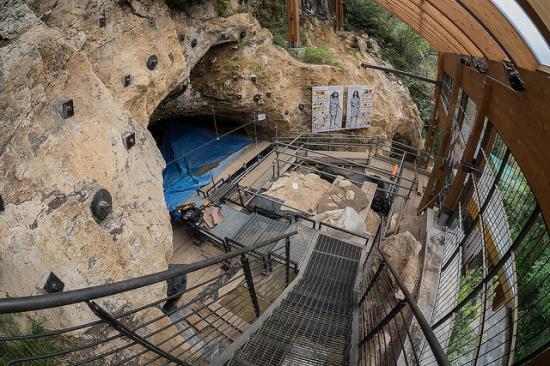The Uluzzian stone tool industry, widely thought to be the product of anatomically modern humans, may actually have its roots in a stone tool tradition linked to Neanderthals
Source - http://popular-archaeology.com/issue/june-2013/article/new-findings-on-prehistoric-stone-tool-industry-in-italy
 The Grotta di Fumane, or Fumane Cave. Thilo Parg, Wikimedia Commons
The Grotta di Fumane, or Fumane Cave. Thilo Parg, Wikimedia Commons
A newly released study published ‘in press’ in the Journal of Human Evolution suggests that the Uluzzian stone tool industry, generally regarded by scholars to be associated with anatomically modern humans, has its roots in the Mousterian industry, a stone tool tradition that has usually been associated with Neanderthals.
In the study, Marco Peresani of the Universitá di Ferrara, Italy, and colleagues conducted an extensive examination of the lithic and bone technologies from assemblages recovered from the Fumane Cave in northern Italy. The Uluzzian is characterized as a lithic flake-dominated industry that exhibits various technological innovations, most of which are associated with the kinds of lithic technology that anatomically modern humans brought to Europe during the Middle-Upper Paleolithic transition, or arguably sometime between 40,000 and 50,000 years BP. They found that the Levallois production technique was the most used method used in the initial stage of the Uluzzian, and that Mousterian-style side scrapers and points were a clear feature in the initial phase. The Levallois, a production technique that was used to produce simple tools such as scrapers and knives by striking flakes from a prepared lithic core, has typically been associated with Neanderthals, as is the Mousterian industry. The authors of the study thus suggest that the Uluzzian cannot be conclusively viewed as one proxy indicator of the first presence of anatomically modern humans in Europe, who are thought to be the carriers of the cultural changes related to the Aurignacian, the first Eurasian stone tool industry clearly associated with modern humans.
The Uluzzian was first discovered in the early 1960s at the site of Grotta del Cavallo in southern Italy. This cave yielded about 7 meters of archaeological deposits representing the period during which scientists have suggested that Neanderthals were replaced by modern humans. Two milk teeth, attributed at the time to Neanderthals, were unearthed in 1964 by Arturo Palma di Cesnola (emeritus of the University of Siena) from the Uluzzian layers. The Uluzzian culture has been identified at more than 20 separate sites across Italy, and is characterised as consisting of an array of denticulates, sidescrapers, retouched pieces and splintered pieces, distinguished by a production process that differed from that of the earlier Mousterian (associated with Neanderthals) and the proto-Aurignacian (associated with anatomically modern humans).* Finds have also included what has been interpreted as personal ornaments, bone tools and colorants —- items typically associated with modern human symbolic behavior. Because the teeth from Cavallo were identified as belonging to Neanderthals who lived around 200,000 to 40,000 years ago, it was suggested that the Uluzzian and the complex ornaments and tools within it were also produced by Neanderthals.* But in a study published in 2011 in the journal Nature, Stefano Benazzi of the University of Vienna and his colleagues were able to compare digital models derived from micro-computed tomography scans of the human remains from Grotta del Cavallo with those of a large modern human and Neanderthal dental sample: "We worked with two independent methods: for the one, we measured the thickness of the tooth enamel, and for the other, the general outline of the crown. By means of micro-computed tomography it was possible to compare the internal and external features of the dental crown. The results clearly show that the specimens from Grotta del Cavallo were modern humans, not Neanderthals as originally thought.”**
The latest study results from Fumane Cave led by Peresani, however, add more complexity to the debate.
_________________________________________________________
*http://dx.doi.org/10.1016/j.jhevol.2013.12.007
** The Early dispersal of modern humans in Europe and implications for Neanderthal behaviour. Benazzi, S., Douka, K., Fornai, C., Bauer, C.C., Kullmer, O., Svoboda, J., Pap, I., Mallegni, F., Bayle, P., Coquerelle, M., Condemi, S., Ronchitelli, A., Harvati, K., Weber, G.W. In. Nature, Nov. 3, 2011. DOI 10.1038/nature10617
The study: "Early human presence in the Arctic: Evidence from 45,000-year-old mammoth remains," by V.V. Pitulko; A.N. Tikhonov; P.A. Nikolskiy; K.E. Kuper at Russian Academy of Sciences in St. Petersburg, Russia; E.Y. Pavlova at Arctic and Antarctic Research Institute in St. Petersburg, Russia; R.N. Polozov at St. Petersburg Pediatric Medical University in St. Petersburg, Russia.